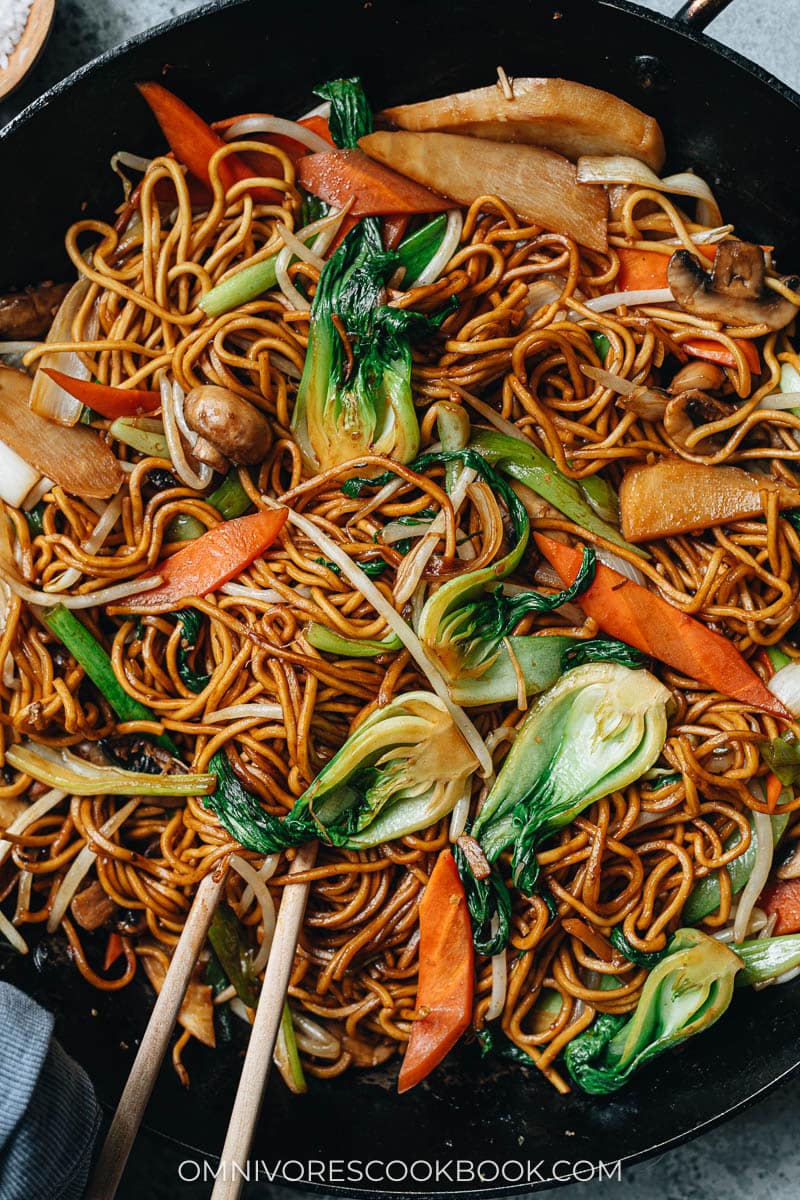
When I order chow mein in a restaurant, I have noticed though that they tend to skimp on the vegetables. That’s why I really prefer the homemade version of vegetarian chow mein because I can load it up with more vegetables. Plus, it’s so versatile I can switch it up with whatever I have on hand. It is also part of my Authentic Chinese noodle recipes collection because making my own sauce gives me full control over the balance of oils and seasonings, which always leads to a more satisfying bowl.
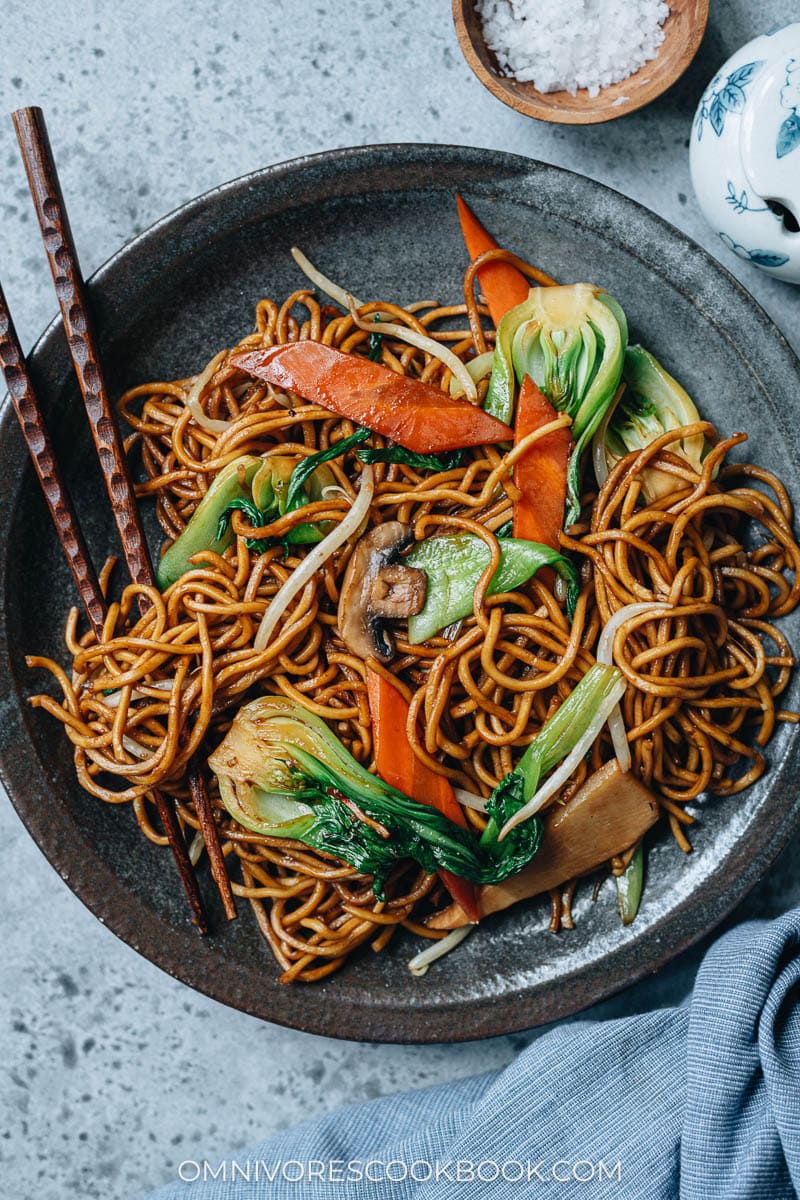
Ingredients
What type of noodles to use
The best type of noodles to use in vegetable chow mein is chow mein noodles.
There are two types of chow mein noodles that I love:
Hong Kong Pan Fried Noodles
These are fresh thin egg noodles that are quite chewy and get crispy when you pan fry them in oil. They are made for making pan fried noodles, and they are perfect for chow mein as well.
To use pan fried noodles, you can soak them in boiling water for 1 minute and they are ready to go into the stir fry.
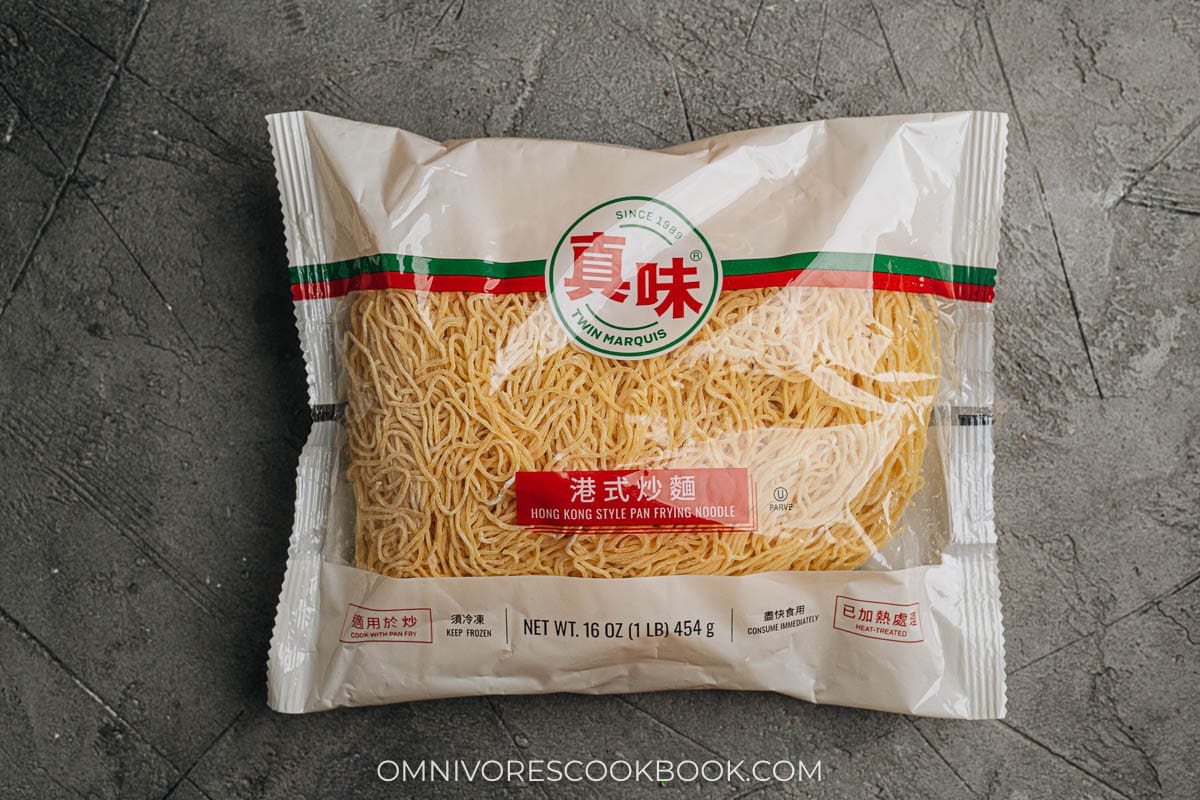
Heat Treated Chow Mein Noodle
These are cooked chow mein noodles that do not require boiling. They are quite similar to packaged Japanese Yakisoba or Chuka noodles, where you can directly put the noodles into the stir fry from the bag.
I like to use the Twin Marquis Chow Mein Noodles when I can find them, because it saves quite some time from boiling the noodles.
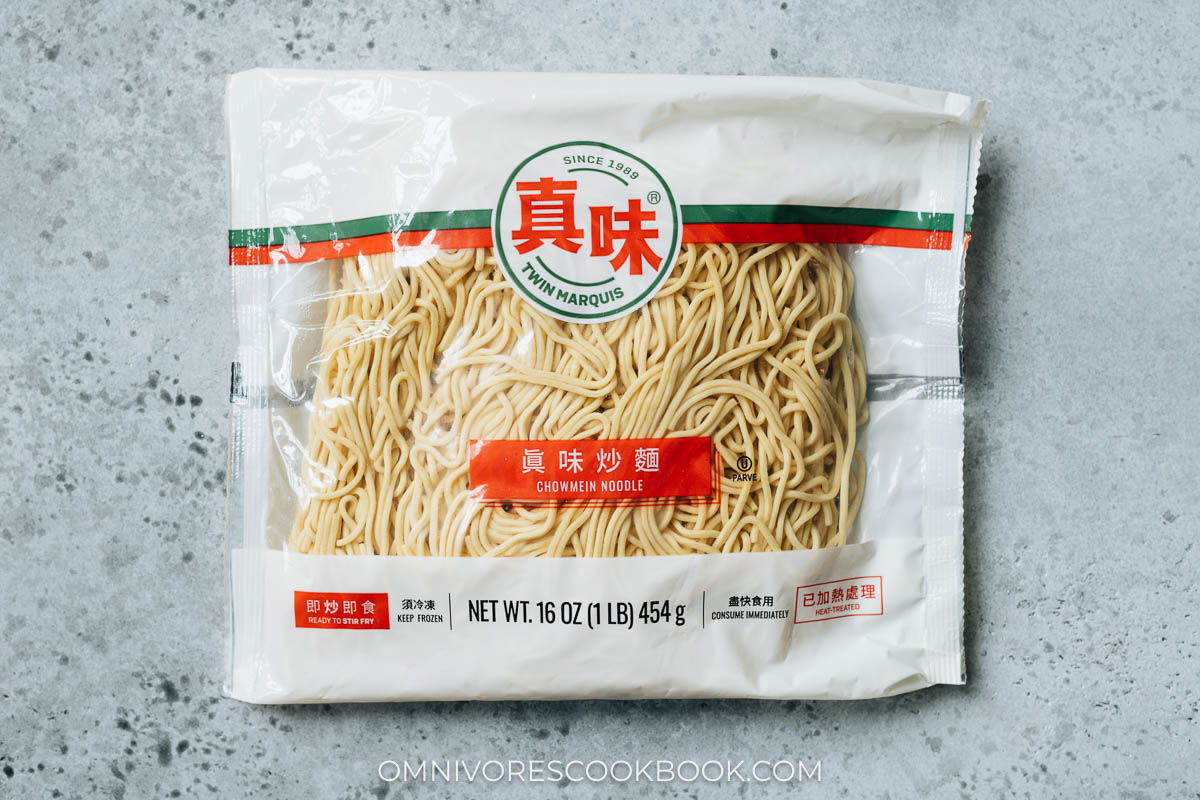
You can find both types of fresh noodles at the refrigerated or freezer section in Chinese markets or large Asian grocery stores such as H Mart. You can also purchase Hong Kong Pan Fried Noodles from Umami Cart.
Dried noodles
Dried chow mein noodles are another option if you cannot find the fresh type. In this case, make sure you always cook the noodles 1 minute less than the package indicated, so they won’t turn too soggy during the stir frying process.
Spaghetti noodles are another great option if that’s all you have on hand, since they have the same ingredients like chow mein noodles.
Mise en place
When you’re ready to cook, your table should have:
- Mixed sauce
- Minced ginger
- Prepped vegetables (bok choy, bean sprout, carrot, mushroom, bamboo shoot and green onion)
- Noodles (boiled and ready to use if not using the heat treated type)
- Sesame oil (or chili oil)
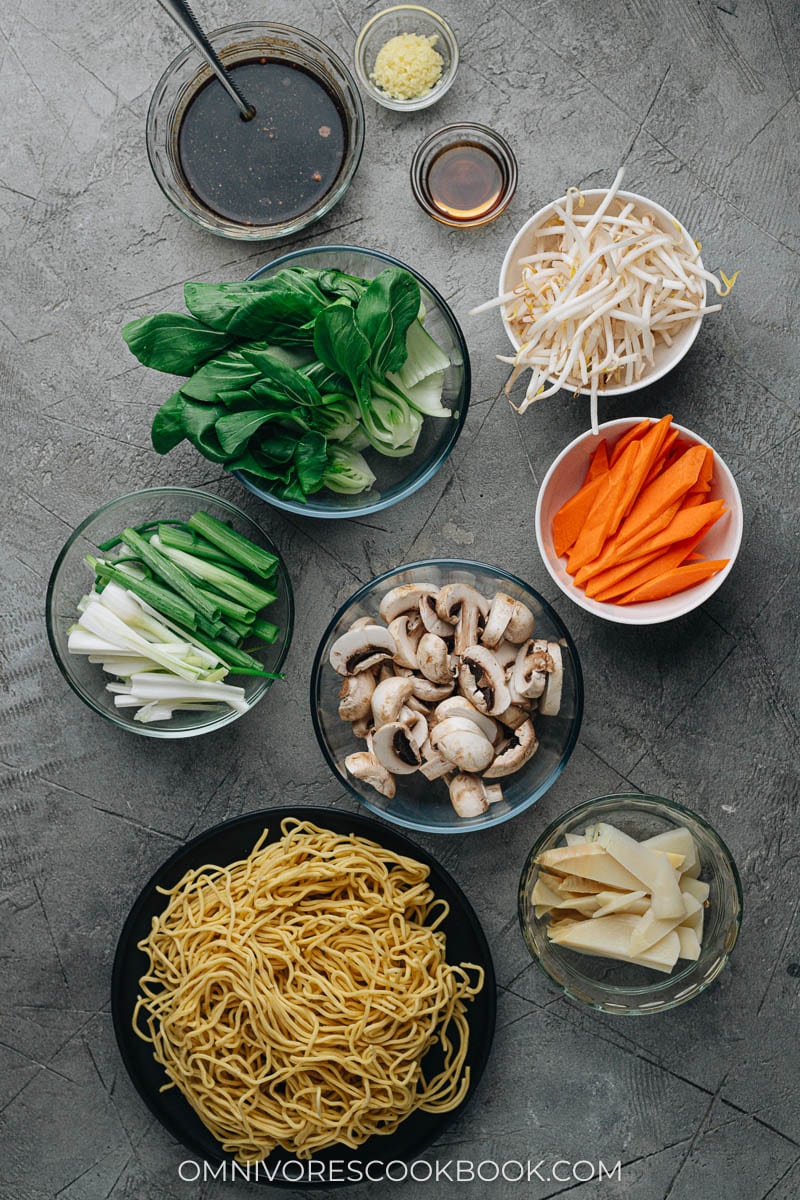
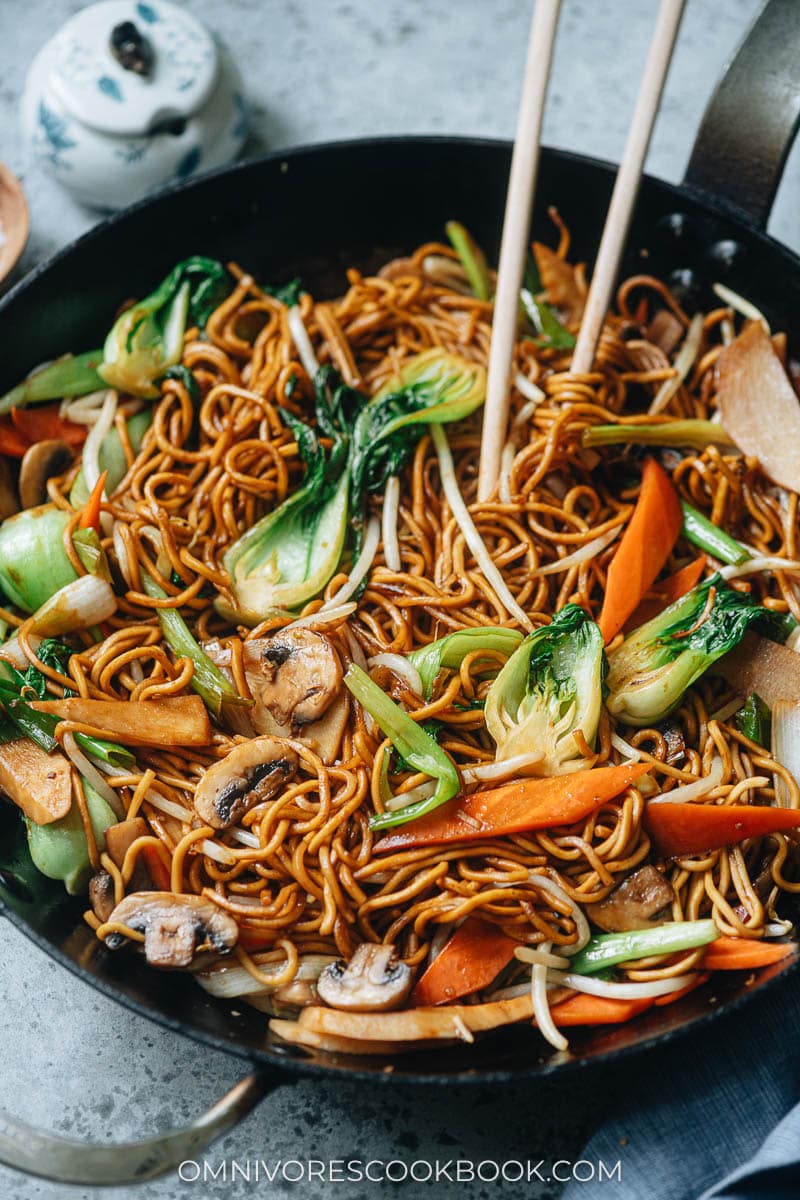
How to replace vegetables
I like to use vegetables of different colors and texture to make my vegetarian chow mein. Here are some other veggies that are great for this dish:
- Bell pepper or hot pepper, sliced
- Cabbage or napa cabbage, shredded
- Other leafy greens such as spinach, Chinese broccoli, and yu choy
- Broccoli, cut into florets and blanched
- Different types of mushrooms
- Onions or shallots, sliced
NOTE: every vegetable requires different cooking times. Make sure you add them by the order so they won’t be over cooked.
How to make vegetarian chow mein
To make vegetarian chow mein:
- Saute the aromatics
- Cook the mushrooms and carrot
- Cook the baby bok choy
- Add the green onion
- Add the noodles and the sauce
- Cover the pan to steam quickly
- Add the bean sprouts
- Mix everything together
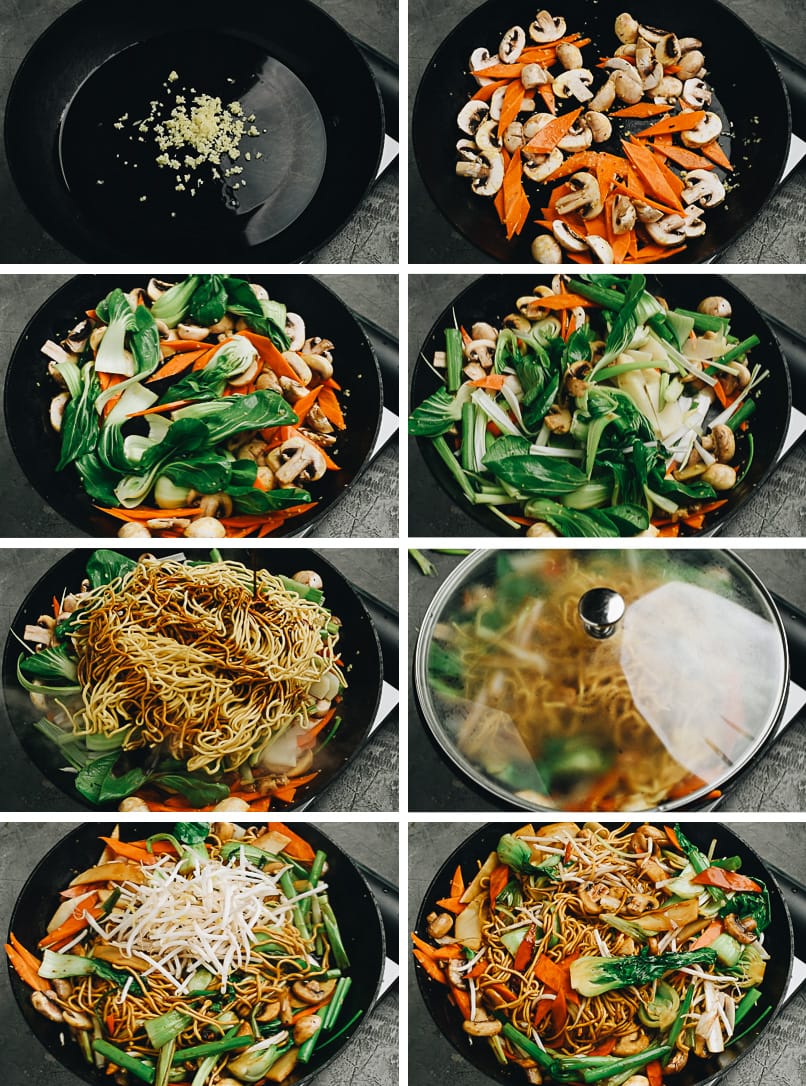
How to serve vegetarian chow mein
A dish like vegetarian chow mein is an excellent option for a quick weeknight meal by itself. If you’re serving a multi-course dinner, you can also serve this one as a side dish.
This homemade version of vegetarian chow mein will make you want to eat all your vegetables. Customize it with your favorite seasonal veggies to shake things up every time!

Other delicious vegetarian recipes
- Pan Fried Tofu (脆皮豆腐)
- Asparagus Salad with Mushroom and Eggs
- Stir-fried Cauliflower with Tomato Sauce
- Spicy Eggplant Salad (凉拌茄子)
- Summer Vegetable Bibimbap
- Vegetable Pan Fried Noodles
Chinese Cooking Made Easy
Are you new to this website? This free email series is a great place to start. I’ll walk you through a few of my most popular recipes and show you how and why they work. You’ll quickly start to cook better Chinese food in your own kitchen.
Watch video
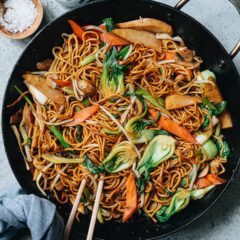
Vegetarian Chow Mein (素菜炒面)
Ingredients
- 10 oz fresh chow mein noodles (or 6 oz / 170 g dried chow mein noodles)
Sauce
- 1/4 cup vegetable stock
- 2 tablespoons vegetarian oyster sauce
- 1 tablespoon Shaoxing wine (or dry sherry)
- 2 teaspoons light soy sauce (or soy sauce)
- 2 teaspoons dark soy sauce (or soy sauce)
- 1/4 teaspoon white pepper
Stir fry
- 2 tablespoons peanut oil (or vegetable oil)
- 1 tablespoon minced ginger
- 3 oz carrot , peeled and julienned (yield about 1 cup once cut)
- 5 oz white mushrooms , sliced
- 4 oz baby bok choy (about 5 small heads) , chopped
- 4 oz bamboo shoot , sliced (about 1 cup once cut)
- 4 green onions , cut to 2” (5-cm) pieces
- 1 cup bean sprouts
Instructions
- Cook noodles according to the package instructions. Drain and set aside. (You might not need this step if using heat treated fresh noodles)
- Combine all the sauce ingredients in a small bowl, stir to mix well.
- Heat oil in a large skillet over medium high until hot. Add the ginger. Stir a few times to release the fragrance.
- Add the carrots and mushrooms. Cook and stir for 1 minute.
- Add the baby bok choy. Cook and stir for another minute. Then add the bamboo shoot and green onions. Cook and stir for 1 to 2 minutes.
- Spread out the noodles and pour in the sauce. Toss the noodles to mix the sauce. Cover the pan and let steam until the vegetables start to soften.
- Add the bean sprouts. Toss for another minute or so, until the bean sprouts are softened. Transfer everything onto a big plate. Serve hot as a main.
Nutrition

Did you make this recipe?
I’d love to hear how it turned out for you! Please take a moment to leave a 5-star rating ⭐️ and share your thoughts in the comments further down the page. It really helps others discover the recipe too.

Lisa
Stumbled upon this fine recipe: delicious!!!! Thank you for making it vegan and caring about animal welfare!
Willy Heineman
Excellent. The sauce in particular was delicious.
Louise
This recipe is great! I love chow mein, but have always struggled to replicate that takeaway flavour at home – this does it so well!
I would never have thought there was ginger in chow mein, but when that went in it was when it started smelling ‘right’.
My husband had the leftovers and didn’t even realise they were home made!
Jonette
Hi Maggie,
Thank you for this recipe. My carnivore family absolutely love it and the Homemade Oyster Sauce is amazing. No one notices or cares about the absence of meat. It has become a favourite dish that makes a regular appearance on our dinner table.
Mariam
Great recipe, I made this along with the orange chicken (no fry) and egg drop soup. All three were a hit! Can’t wait to try more of your recipes next time.
Dustin
This recipe calls for a Tbsp of minced ginger, but it isn’t mentioned in the instructions. Was this a mistake?
Maggie
Hi Dustin, sorry about the confusion! I just updated the recipe and included the ginger in the recipe instructions.
Christopher Spencer
I’m sure there’s a typo in the recipe. 1 whole teaspoon white pepper is pretty crazy.
Maggie
Hi Christopher, I do like to make the dish quite spicy. You can totally halve the white pepper or only use 1/4 teaspoon if you prefer a less spicy dish.
Beth
Hi Maggie. I made the vegetarian chow mein last night for dinner for me and my husband, the very first recipe I tried from your site! My husband was quite impressed with the flavor and we both enjoyed the different textures of the different ingredients in the dish: noodles, green onions, fresh mushrooms, baby bok choy, and carrot. I didn’t have any bamboo shoots or bean sprouts on hand so I added in about 7 or 8 ounces of pre-cooked tofu.
For me and my taste preferences, I think the oyster sauce was a bit too intense. I felt the oyster sauce gave the dish a bit of a funky (but not in an entirely bad way) taste. I did clean my plate and liked what I ate, but ultimately I just don’t think I’m a fan of oyster sauce. (I bought Premium Oyster Sauce by Lee Kum Kee.) That being said, I am still very glad I made this recipe from your site. My husband really liked it and I will be definitely trying other recipes that you have posted. Again, thank you for sharing 🙂
P.S. What can I do when I come across other recipes of yours that I want to try that have varying amounts of oyster sauce in the dish? Can I just leave it out? Or does the oyster sauce need to be replaced with a different type of thick sauce because that “thickness” might contribute to the body of the sauce??? Like hoisin sauce? Although I’m sure that would change the flavor profile completely. (I have seen vegetarian mushroom not-oyster sauce sauce at the Asian grocery but it’s so pricey that I can’t justify purchasing it, at least not right now since I’ve purchased other items to stock the beginnings of my small Asian pantry.)
Maggie
Hi Beth, I’m glad you and your husband like the dish!
Re oyster sauce replacement – I think the best replacement is hoisin sauce. Oyster sauce adds sweetness and starchiness to the sauce, so you do need to replace it with something similar. Alternatively, you might able to get away with added soy sauce, Shaoxing wine, sugar and cornstarch. Although it’s hard for me to provide a quantity since it might vary depending on the recipe. If you use hoisin sauce as a replacement, I might add less sugar since hoisin is quite sweet.
Beth
Hi Maggie and thanks for your reply and advice re oyster sauce replacement. I think I’d be totally fine using oyster sauce in small amounts in other recipes but it’s good to know that hoisin sauce would be an acceptable substitute. Years ago our natural food health store carried their own brand of hoisin sauce and it was sooooo good. Sadly they discontinued it and I have yet to find a store-bought hoisin sauce that is any good and I’ve been without hoisin sauce for years now 🙁 My most recent hoisin sauce purchase was Sun Luck brand, and while the thickness and mouth feel was quite good, it was really way too sweet and would be strange to use in a savory dish. I would have known that had I checked the ingredient list before I bought it as sugar, molasses, pumpkin, and some other sweetish ingredient were listed among the first ingredients. Anyway, to make a long rambling story short, I’ll be definitely trying your homemade hoisin sauce recipe soonish.
Jody
Hi Maggie! Greetings from Oklahoma City. We have enjoyed every recipe of yours that we’ve tried. I just had to comment on the photograph for this dish. It is umame for the eyes! If I wasn’t already vegan, I would want to be one because of this beautiful dish. Thanks for all of your hard work . You inspire me with every post!
eeljapan
I cooked a 200g package of noodle in two batch for two of us, cooking in two batch, thinking I would have a leftover lunch for myself tomorrow – but no, we finished all! It was too tasty to leave anything behind. I am so happy finally I am accumulating from your site vegetarian / vegan dishes for my vegan friends, but also for myself who is reducing amount of meat in general. Frying noodle was a difficult bit, as quite a bit got stuck to my iron cast pan and didn’t come out. Perhaps I should have added more oil as the recipe says, though I didn’t want to make it too greasy. I will practice more in the coming weeks 🙂
Maggie
I’m glad to hear you like the recipe! Yes, you definitely need to add more oil to the dish if using a cast iron pan. I found starchy food such as noodles will stick to the cast iron pan very easily. Chinese restaurant uses the same trick too, to prevent from sticking and makes the noodles tastier.
Lisa Huff
My family would LOVE this! Yum!
Lucie
Hey !
As a vegetarian and all time fan of asian food I always feel so frustrated at all the meat in there…
So I have loved your recent posts about vegetarian chinese food, please keep them coming 🙂
Lucie.
Virginia
In Cal. we have a place called THE RICE BOWL it served great chow mein using mostly bean sprouts. T Obama’s demanded the thicken sauce be left out/. It became only steamed vegies. Can you tell me w hat the sauce might be? I love vegetables as we were raised with a garden every year. I am so excited with all your information.
Maggie
Hi Virginia, I’m wondering maybe the noodle sauce in my shrimp chow mein recipe is the one you’re looking for: https://omnivorescookbook.com/shrimp-chow-mein/
In this recipe I replaced the original oyster sauce with mushroom sauce. If you do not need a vegetarian dish, check out the shrimp chow mein post. I hope this is helpful 🙂
Maumita
Lovely post :). Thanks for the tips 🙂
Wei @ Red House Spice
Hi Maggie, Greeting from another Chinese blogger (brand new)! Discovered your site since I started my own blog. Adore your blog! So professional and inspirational! And like your photo style too. I’m from Gansu and lived in Beijing for many years before I came to Europe. I used to eat at Jin Ding Xuan a lot (the one near Yong He Gong) with my colleagues after work (around 1 am) because it was one of the few good restaurants which opened 24 hours. This post reminds me of those sweet memories…. Anyway, very pleased to meet you (would like to meet you one day in person). Ps, Thank you so much for your trick on hiding long Pinterest images. Have a great day!
Maggie
Hi Wei, sorry it took me forever to reply your message! Gosh I just realized it had been a month since I reply my blog comment last time.
I’m glad to hear you have passion about Chinese food too and would like to share it with the rest of the world. I’ve never been to Gansu before, but I believe you have great noodles there? These days I’m very bad at blog commenting, but I’ll follow your blot and promote it for sure!
I still haven’t replied your email but will do soon! Happy cooking and have a delicious week ahead 🙂
Wei @ Red House Spice
Thank you very much Maggie! Yes, there are so many great noodle dishes in North-west of China. I saw you wrote about Lanzhou Beef Noodles before. That was my regular breakfast when I was a teenager! Anyway, have a great weekend!